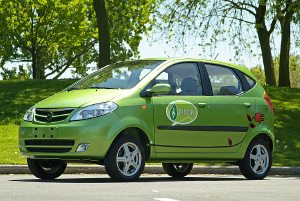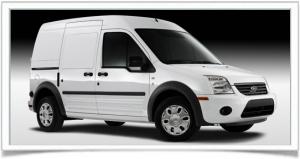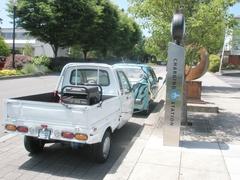 In the next year or so, after only a century or so of trying, the electric car may break free of the lunatic fringe and become a mainstream transportation option for everyday drivers.
In the next year or so, after only a century or so of trying, the electric car may break free of the lunatic fringe and become a mainstream transportation option for everyday drivers.
The next step forward for electric cars will come on Aug. 2, when Nissan is expected to unveil the first of three electric models in three vehicle segments that the automaker will reportedly sell en masse by 2013 in the United States, Japan and Europe.
In fact, fanatics (aka “early adopters”) have been gutting regular car cars and packing them with a thousand pounds of golf cart batteries for years. But very soon it will be possible for drivers other than those who already have a home-brewed solar array atop their home to have a chance to whir quietly to work using household electric current for propulsion. (Photo, Canadian electic vehicle, the Maya 300)
This comes after a long history of mostly dashed hopes, unrealized dreams and no shortage of P.T. Barnum-esque wild claims unsupported by reality. But this time, mass-produced electric cars really are preparing to begin trickling into showrooms, a reality cemented by U.S. government loans to the three companies that are gearing up for production.
Ford, Nissan and Tesla have received U.S. government loans that the companies say will help them tool up to manufacture their planned electric models, with the first electric cars arriving in 2010 from Ford and Nissan. Tesla says production of its sleek $57,400 Model S will commence in late 2011.
Growing market
These cars aren’t likely to be cheap, but Nissan at least is promising to be price-competitive in the premium compact car segment. The company won’t say whether that competitive price will be the one before or after the $7,500 federal tax credit, but it seems likely that the tax break will be needed to help make these cars reasonably competitive with gas-powered alternatives.
Within five years, the market for electric cars could reach between 270,000 and 335,000 units per year in the U.S., predicts Art Spinella, president of CNW Research, a market research firm in Bandon, Ore. That would certainly confirm the arrival of the electric car as a “real” product in a way that has never happened before, though it would still represent only about 2 percent of total sales, Spinella points out.
That means that the cars that are supposed to save the world will still sell in total numbers in the U.S. that are similar to those of the number three-selling pickup truck, the macho Dodge Ram pickup. So while everyone won’t be propelled by electrons anytime soon, for the first time, everyone can at least consider that as an option when the buy their next car.
No sooner did consumers come to embrace the notion that hybrid-electric cars need not be plugged in than battery electrics will arrive to test drivers’ willingness to rely on plug-in-only cars.
 Nissan has demonstrated its electric drive system installed in its trendy Cube compact model (photo, left), but the production car will be its own model, said Mark Perry, Nissan’s director of product planning. The car will have space for five occupants and will have a driving range of 100 miles on a charge, a distance that is sufficient for the daily driving needs of 98 percent of Americans, according to the company.
Nissan has demonstrated its electric drive system installed in its trendy Cube compact model (photo, left), but the production car will be its own model, said Mark Perry, Nissan’s director of product planning. The car will have space for five occupants and will have a driving range of 100 miles on a charge, a distance that is sufficient for the daily driving needs of 98 percent of Americans, according to the company.
Nissan will target an upmarket customer with its electric model, complete with the premium amenities and safety features expected by the kind of customers who might otherwise buy a Mini Cooper rather than say, a Toyota Yaris. Nissan will begin offering this new model in 10 to 15 markets nationwide in 2010, gradually expanding to full availability in 2012, said Perry.
Electric minivan
Ford, meanwhile, is gearing up to offer its Transit Connect commercial minivan as an electric model next year. This will also start out in limited numbers, reported Rob Stevens, Ford’s chief engineer for commercial vehicles. The Transit Connect (photo, right) will be available with either of two lithium-ion battery packs, a 21 kilowatt-hour pack or a 28 kWh pack. The first will offer a driving range of about 70 miles and the second will go about 100 miles, he said, and the vehicle will have a top speed of 70 mph.

Ford isn’t ready to talk about the electric Transit Connect’s price, but acknowledges that even after the tax credit it will be higher than that of the gasoline model. Smith Electric Vehicles, the British company providing the electric drivetrain, enjoys the benefit of selling these vehicles to customers who are able to escape London’s congestion fee.
The electric Transit Connect will only sell through select Ford dealers, but in 2011 the company will follow that with a higher-volume electric version of either its Focus or Fiesta small car, which will be sold through all of its dealers to regular customers.

With the recent grants of federal money, both Ford and Nissan are solidly positioned to begin manufacturing regular production versions of the cars that already exist in drivable prototype form.
Tesla, the Silicon Valley startup that suffers no shortage of bold claims but that missed by nearly two years its announced production target for its first electric model, the Tesla Roadster (photo, left), also says that it will have a more affordable four-door sedan ready for production by late 2011.
Now that the company says it has delivered more than 500 of its tiny $109,000 Roadster models to customers, perhaps it can make this forecast with greater reliability. The new car, called the Model S, is slated to cost $57,400 when equipped with a battery pack with a range of 160 miles. Larger batteries with 230- and 300-mile driving ranges will also be available, according to Tesla.
With the Tesla’s anticipated long driving range, cultivation of a network of fast charging stations along highways could even make electric cars practical for trips someday, rather than just the around-town commuting that is expected to be the primary duty of such cars.
To support urban use, office parking garages and shopping centers are a prime targets for charging stations, according to Perry. Regular wall-type 110-volt outlets will take considerable time to fully recharge these cars’ battery packs and would probably mostly be used to keep the batteries topped up.
Better charging stations
Nissan says its car takes 14 hours to charge the lithium ion batteries completely on standard 110-volt power, but that a 220-volt charger that will do the job in about 4 hours. The expectation is that customers will have a 220-volt charger installed in their home for quick everyday charges — which might even be coordinated with their utility to get a better rate by charging in the middle of the night — and use the 110-volt capability when they are parked elsewhere, said Perry.
Car makers are working with power utilities and others to define the standard for a planned 440-volt charger, which would recharge Nissan’s electric car to 80 percent of capacity — good for 80 miles of driving — in 26 minutes and the Tesla Model S’s in 45 minutes.
 This would make it practical for gas stations to have charging stations that drivers could use if they needed to drive somewhere beyond the range of a full charge. Although 26 minutes is still a good while to wait, it turns out that the average customer’s visit to a fast food restaurant lasts 20 minutes, so it could be that McDonalds will emerge as a player in the emerging industry of recharging electric cars.
This would make it practical for gas stations to have charging stations that drivers could use if they needed to drive somewhere beyond the range of a full charge. Although 26 minutes is still a good while to wait, it turns out that the average customer’s visit to a fast food restaurant lasts 20 minutes, so it could be that McDonalds will emerge as a player in the emerging industry of recharging electric cars.
The expected increase in electric car manufacturers draws concern in some quarters, where there is concern about toxic battery components and about the fact that most electricity produced in the U.S. today comes from coal-fired power plants.
Nissan’s Perry points out that materials used in the batteries are valuable and will be recovered for reuse when the car is retired. Addressing concerns that battery electric cars only move the source of pollution from the tailpipe to the smokestack, Perry explained that even with today’s coal-heavy mix of electric power generation, electric cars produce only 40 percent the amount of CO2 as gas-powered cars, and this percentage can improve over time as utilities shift away from coal.
And they’ll be even cleaner if some of those early adopters can charge them from their homes’ roof-top solar arrays.
Reproduced with permission of MSNBC from original report on MSNBC.com on July 16, 2009; permission conveyed through Copyright Clearance Center, Inc.




















The charging station shown above is located in Lake Oswego, OR, just south of Portland.